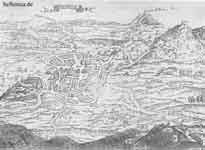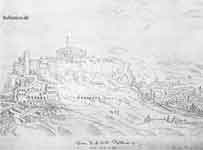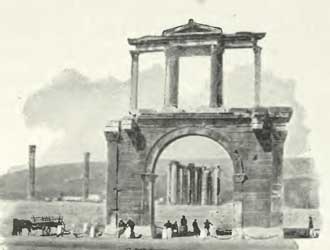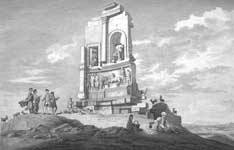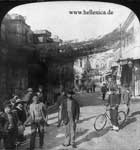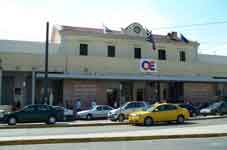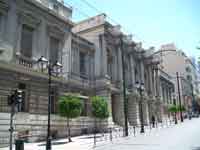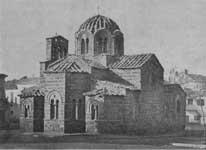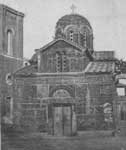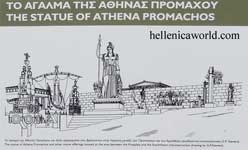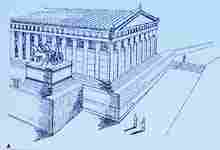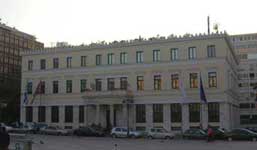

Administrative Region : Attica
Regional unit : Central Athens
Athens (/ˈæθɨnz/;[1] Modern Greek: Αθήνα, Athína, IPA: [aˈθina], Katharevousa: Ἀθῆναι, Athine, Ancient Greek: Ἀθῆναι, Athēnai), is the capital and largest city of Greece. Athens dominates the Attica periphery and is one of the world's oldest cities, as its recorded history spans around 3,400 years. Classical Athens was a powerful city-state. A centre for the arts, learning and philosophy, home of Plato's Academy and Aristotle's Lyceum,[2][3] it is widely referred to as the cradle of Western civilization and the birthplace of democracy,[4][5] largely due to the impact of its cultural and political achievements during the 5th and 4th centuries BC on the rest of the then known European continent.[6] Today a cosmopolitan metropolis, modern Athens is central to economic, financial, industrial, political and cultural life in Greece and it is rated as an Alpha world city.[7] In 2008, Athens was ranked the world's 32nd richest city by purchasing power[8] and the 25th most expensive[9] in a UBS study.
The Greek capital has a population of 655,780[10] (796,442 back in 2004)[11] within its administrative limits[12] and a land area of 39 km2 (15 sq mi).[13] The urban area of Athens (Greater Athens and Greater Piraeus) extends beyond the administrative municipal city limits, with a population of 3,074,160 (in 2011),[14] over an area of 412 km2 (159 sq mi).[13] According to Eurostat, the Athens Larger Urban Zone (LUZ) is the 7th most populous LUZ in the European Union (the 4th most populous capital city of the EU) with a population of 4,013,368 (in 2004).
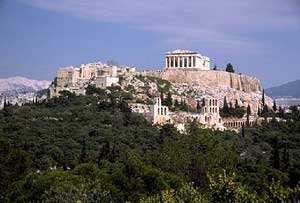
The Acropolis
The heritage of the classical era is still evident in the city, represented by a number of ancient monuments and works of art, the most famous of all being the Parthenon, widely considered a key landmark of early Western civilization. The city also retains a vast variety of Roman and Byzantine monuments, as well as a smaller number of remaining Ottoman monuments projecting the city's long history across the centuries. Athens is home to two UNESCO World Heritage Sites, the Acropolis of Athens and the medieval Daphni Monastery. Landmarks of the modern era, dating back to the establishment of Athens as the capital of the independent Greek state in 1833, include the Hellenic Parliament (19th century) and the Athens Trilogy consisting of the National Library of Greece, the Athens University and the Academy of Athens. Athens was the host city of the first modern-day Olympic Games in 1896, and 108 years later it welcomed home the 2004 Summer Olympics.[15] Athens is home to the National Archeological Museum, featuring the world's largest collection of ancient Greek antiquities, as well as the new Acropolis Museum.

The Erechtids / Cecropidae Kings of Athens
Etymology
Athena, patron goddess of Athens
Further information: Names of European cities in different languages: A
In Ancient Greek, the name of Athens was: Ἀθῆναι [atʰɛ̂ːnai], related tο the name of the goddess Athena (Attic Ἀθηνᾶ [atʰɛːnâː] and Ionic Ἀθήνη [aˈtʰɛːnɛː]). In Homeric Greek the city's name was in the singular form (Ἀθήνη[16]) then changed in the plural, like those of Θῆβαι (Thēbai), Μυκῆναι (Mukēnai), and Δελφοί (Delphoi).
An etiological myth explaining how Athens acquired this name was well known amongst ancient Athenians and even became the theme of the sculpture on the West pediment of the Parthenon. Both Athena and Poseidon requested to be patrons of the city and to give their name to it, so they competed with one another for the honor, offering the city one gift each. Poseidon produced a salt water spring by striking the ground with his trident, symbolizing naval power. Athena created the olive tree, symbolizing peace and prosperity. The Athenians, under their ruler Cecrops, accepted the olive tree and named the city after Athena.
Since the official abandonment of Katharevousa Greek in the 1970s, the demotic Αθήνα (Athína / [aˈθina]) has become the city's official name in place of Ἀθῆναι.
The city is often referred to as τὸ κλεινὸν ἄστυ, its nickname in Greek, which means in English the Glorious City.
History
Main article: History of Athens
Acropolis of Athens.
.
Dipylon Kouros, Marble, 620-610 BC, Kerameikos Archaeological Museum, Athens
Dipylon vase of Geometric style,750 BC
The oldest known human presence in Athens is the Cave of Schist which has been dated to between the 11th and 7th millennium BC.[17] Athens has been continuously inhabited for at least 7000 years.[18][19] By 1400 BC the settlement had become an important centre of the Mycenaean civilization and the Acropolis was the site of a major Mycenaean fortress whose remains can be recognised from sections of the characteristic Cyclopean walls.[20] Unlike other Mycenaean centers, such as Mycenae and Pylos, it is not known whether Athens suffered destruction in about 1200 BC, an event often attributed to a Dorian invasion, and the Athenians always maintained that they were "pure" Ionians with no Dorian element. However, Athens, like many other Bronze Age settlements, went into economic decline for around 150 years following this.
Iron Age burials, in the Kerameikos and other locations, are often richly provided for and demonstrate that from 900 BC onwards Athens was one of the leading centers of trade and prosperity in the region.[21] The leading position of Athens may well have resulted from its central location in the Greek world, its secure stronghold on the Acropolis and its access to the sea, which gave it a natural advantage over inland rivals such as Thebes and Sparta.
By the 6th century BC, widespread social unrest led to the reforms of Solon. These would pave the way for the eventual introduction of democracy by Cleisthenes in 508 BC. Athens had by this time become a significant naval power with a large fleet, and helped the rebellion of the Ionian cities against Persian rule. In the ensuing Greco-Persian Wars Athens, together with Sparta, led the coalition of Greek states that repelled the Persians, defeating them decisively at Marathon in 490 BC and crucially at Salamis in 480 BC.
Delian League,under the leadership of Athens' before the Peloponnesian War in 431 BC
The decades that followed became known as the Golden Age of Athenian democracy, during which time Athens became the leading city of Ancient Greece, with its cultural achievements laying the foundations of Western civilization. The playwrights Aeschylus, Sophocles and Euripides all lived and worked in Athens during this time, as did the historians Herodotus and Thucydides, the physician Hippocrates, and the philosopher Socrates. Guided by Pericles, who promoted the arts and fostered democracy, Athens embarked on an ambitious building program that saw the construction of the Acropolis of Athens (including the Parthenon), as well as empire-building via the Delian League. Originally intended as an association of Greek city-states to continue the fight against the Persians, the league soon turned into a vehicle for Athens' own imperial ambitions. The resulting tensions brought about the Peloponnesian War (431-404 BC), in which Athens was defeated by its rival Sparta.
By the end of Late Antiquity the city experienced decline followed by recovery in the second half of the Middle Byzantine Period (9th–10th centuries AD), and was relatively prosperous during the Crusades, benefiting from Italian trade. In 1453 it was conquered by the Ottoman Empire and entered a long period of decline.
Following the Greek War of Independence, Athens was chosen as the capital of the newly independent Greek state in 1834, largely due to historical and sentimental reasons. At the time it was a town of modest size built around the foot of the Acropolis. The first King of Greece, Otto of Bavaria, commissioned the architects Stamatios Kleanthis and Gustav Schaubert to design a modern city plan fit for the capital of a state.
The first modern city plan consisted of a triangle defined by the Acropolis, the ancient cemetery of Kerameikos and the new palace of the Bavarian king (now housing the Greek Parliament), so as to highlight the continuity between modern and ancient Athens. Neoclassicism, the international style of this epoch, was the architectural style through which Bavarian, French and Greek architects such as Hansen, Klenze, Boulanger or Kaftantzoglou designed the first important public buildings of the new capital. In 1896 Athens hosted the first modern Olympic Games. During the 1920s a number of Greek refugees, expelled from Asia Minor after the Greco-Turkish War (1919-1922), swelled Athens' population; nevertheless it was most particularly following World War II, and from the 1950s and 1960s, that the population of the city exploded, and Athens experienced a gradual expansion in all directions. In the 1980s it became evident that smog from factories and an ever increasing fleet of automobiles, as well as a lack of adequate free space due to congestion, had evolved into the city's most important challenge. A series of anti-pollution measures taken by the city's authorities in the 1990s, combined with a substantial improvement of the city's infrastructure (including the Attiki Odos motorway, the expansion of the Athens Metro, and the new Athens International Airport), considerably alleviated pollution and transformed Athens into a much more functional city. In 2004 Athens hosted the 2004 Summer Olympics with great success.
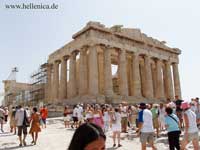
Geography
View of Mount Penteli, the second-tallest mountain surrounding Athens.
Athens sprawls across the central plain of Attica that is often referred to as the Athens or Attica Basin (Greek: Λεκανοπέδιο Αττικής). The basin is bounded by four large mountains: Mount Aegaleo to the west, Mount Parnitha to the north, Mount Penteli to the northeast and Mount Hymettus to the east.[22] Beyond Mount Aegaleo lies the Thriasian plain, which forms an extension of the central plain to the west. The Saronic Gulf lies in the southwest. Mount Parnitha is the tallest of the four mountains (1,413 m (4,636 ft))[23] and it has been declared a national park.
Athens is built around a number of hills. Lycabettus is one of the tallest hills of the city proper and provides a view of the entire Attica Basin. The geomorphology of Athens is deemed to be one of the most complex in the world due to its mountains and causes a temperature inversion phenomenon which, along with the failure of the Greek Government to control industrial pollution, is responsible for the air pollution problems the city has recently faced.[19][24] This issue is not characteristic of Athens alone; for intsance, Los Angeles and Mexico City also suffer from similar geomorphology inversion problems.[19]
|
|
Climate
Athens has a Subtropical Mediterranean climate (Köppen Csa). The dominant feature of Athens climate is alternation between prolonged warm and dry summers and mild, wet winters.[25] With an average of 414.1 millimetres (16.30 in) of yearly precipitation, rainfall occurs largely between the months of October and April. July and August are the driest months, where thunderstorms occur sparsely once or twice a month. Winters are cool and rainy, with a January average of 8.9 °C (48.0 °F); in Nea Filadelfeia and 10.3 °C (50.5 °F) in Hellinikon; Snowstorms are infrequent but can cause significant disruption when they occur. Snowfalls are more frequent in the northern suburbs of the city.[26]
Mount Parnitha creates a rainshadow for the city, as a result of which precipitation is typically lower than in other parts of the country. Daily average highs for July have been measured at 33.5 °C (92.3 °F) at Nea Filadelfeia weather station, but other parts of the city may be even warmer, in particular western parts partially due to industrialization or mainly due to various natural reasons (knowledge of which we have at least from the mid 19th century).[27][28][29] Temperatures often surpass 38 °C (100 °F) during the city's notorious heatwaves.[22][30]
The city of Athens is affected by the urban heat island effect in some areas which is caused by human activity,[31][32] altering its temperatures compared to the surrounding rural areas,[33][34][35][36] that has detrimental effects on energy usage, expenditure for cooling,[37][38] and health.[32] The urban heat island of the city has been found partially responsible also for alterations of the climatological temperature time-series of specific Athens meteorological stations due to its impact on the temperatures and the temperatures trends recorded by some meteorological stations.[39][40][41][42][43] On the other hand specific meteorological stations such as the National Garden station and Thiseio meteorological station are less affected or do not experience the urban heat island[33][44]
Athens holds the World Meteorological Organisation record for the highest temperature ever being recorded in Europe of 48.0 °C (118.4 °F) which was recorded in Elefsina and Tatoi suburbs of Athens on 10 July 1977.[45]
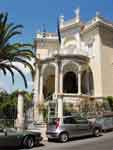
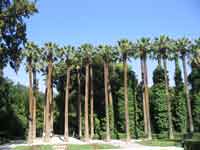
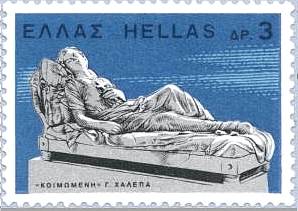
Proto Nekrotafio (First Cemetery) Tomb of Sophia Afentaki (Σοφία Αφεντάκη), with the inscription "Yannoulis Halepas epoiei"
| Climate data for National Observatory of Athens (Thiseio), 107 m asl (1971–2000 for temperature; 1961–1990 for rainfall) | |||||||||||||
|---|---|---|---|---|---|---|---|---|---|---|---|---|---|
| Month | Jan | Feb | Mar | Apr | May | Jun | Jul | Aug | Sep | Oct | Nov | Dec | Year |
| Average high °C (°F) | 13.3 (55.9) |
12.7 (54.9) |
14.4 (57.9) |
18.3 (64.9) |
22.7 (72.9) |
30.6 (87.1) |
33.1 (91.6) |
32.8 (91.0) |
30.5 (86.9) |
25.5 (77.9) |
20.0 (68.0) |
16.1 (61.0) |
22.50 (72.50) |
| Daily mean °C (°F) | 10.0 (50.0) |
9.4 (48.9) |
11.1 (52.0) |
13.8 (56.8) |
17.7 (63.9) |
25.5 (77.9) |
28.0 (82.4) |
27.7 (81.9) |
25.0 (77.0) |
20.5 (68.9) |
16.1 (61.0) |
12.7 (54.9) |
18.13 (64.63) |
| Average low °C (°F) | 6.7 (44.1) |
6.8 (44.2) |
8.2 (46.8) |
11.6 (52.9) |
16.0 (60.8) |
20.4 (68.7) |
22.8 (73.0) |
22.5 (72.5) |
19.4 (66.9) |
15.1 (59.2) |
11.2 (52.2) |
8.2 (46.8) |
14.08 (57.34) |
| Rainfall mm (inches) | 44.6 (1.756) |
48.3 (1.902) |
42.6 (1.677) |
28.2 (1.11) |
17.2 (0.677) |
9.7 (0.382) |
4.2 (0.165) |
4.6 (0.181) |
11.9 (0.469) |
47.7 (1.878) |
50.6 (1.992) |
66.6 (2.622) |
376.2 (14.811) |
| Source: National Observatory of Athens[46] | |||||||||||||
Below are the meteorological data for the northern suburb of Nea Filadelfeia :
| Climate data for Athens | |||||||||||||
|---|---|---|---|---|---|---|---|---|---|---|---|---|---|
| Month | Jan | Feb | Mar | Apr | May | Jun | Jul | Aug | Sep | Oct | Nov | Dec | Year |
| Average high °C (°F) | 12.5 (54.5) |
13.5 (56.3) |
15.7 (60.3) |
20.2 (68.4) |
26.0 (78.8) |
31.1 (88.0) |
33.5 (92.3) |
33.2 (91.8) |
29.2 (84.6) |
23.3 (73.9) |
18.1 (64.6) |
14.1 (57.4) |
22.5 (72.5) |
| Daily mean °C (°F) | 8.9 (48.0) |
9.5 (49.1) |
11.2 (52.2) |
14.9 (58.8) |
20.0 (68.0) |
24.7 (76.5) |
27.2 (81.0) |
27.0 (80.6) |
23.3 (73.9) |
18.4 (65.1) |
14.0 (57.2) |
10.5 (50.9) |
17.4 (63.3) |
| Average low °C (°F) | 5.2 (41.4) |
5.4 (41.7) |
6.7 (44.1) |
9.6 (49.3) |
13.9 (57.0) |
18.2 (64.8) |
20.8 (69.4) |
20.7 (69.3) |
17.3 (63.1) |
13.4 (56.1) |
9.8 (49.6) |
6.8 (44.2) |
12.3 (54.1) |
| Rainfall mm (inches) | 56.9 (2.24) |
46.7 (1.839) |
40.7 (1.602) |
30.8 (1.213) |
22.7 (0.894) |
10.6 (0.417) |
5.8 (0.228) |
6.0 (0.236) |
13.9 (0.547) |
52.6 (2.071) |
58.3 (2.295) |
69.1 (2.72) |
414.1 (16.303) |
| % humidity | 74.5 | 72.2 | 68.8 | 61.7 | 53.9 | 46.1 | 43.1 | 45.3 | 53.7 | 66.1 | 74.3 | 76.1 | 60.8 |
| Avg. rainy days | 12.6 | 10.4 | 10.2 | 8.1 | 6.2 | 3.7 | 1.9 | 1.7 | 3.3 | 7.2 | 9.7 | 12.1 | 87.1 |
| Mean monthly sunshine hours | 130.2 | 139.2 | 182.9 | 231.0 | 291.4 | 336.0 | 362.7 | 341.0 | 276.0 | 207.7 | 153.0 | 127.1 | 2,778.2 |
| Source: World Meteorological Organization (UN),[47] Hong Kong Observatory[48] for data of sunshine hours | |||||||||||||
Government
The former Athens Prefecture (blue), within the periphery of Attica (grey).
Athens became the capital of Greece in 1834, following Nafplion which was the provisional capital from 1829. In addition, the municipality of Athens is the capital of the Attica Periphery. Athens can refer either to the municipality of Athens or to the entire Athens Urban Area, which makes up the "City of Athens" that sprawls across the Attica Basin.
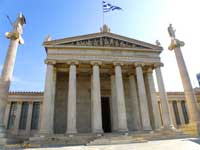
Attica Periphery
The Athens Metropolitan Area sprawling over 2,928.717 km2 (1,131 sq mi) is located within the 3,808 km2 (1,470 sq mi) Attica Periphery. The periphery encompasses the most populated region of Greece, reaching 3,812,330 inhabitants in 2011,[12] while it is however, one of the smallest peripheries in the country.
The Attica Periphery itself is split into eight peripheral units, out of which the first four form Greater Athens, while the peripheral unit of Piraeus forms Greater Piraeus. Together they make up the contiguous built up urban area of the Greek capital, spanning over 412 km2 (159 sq mi).[49]
North Athens (Urban Area)
West Athens (Urban Area)
Central Athens (Urban Area)
South Athens (Urban Area)
East Attica (Metropolitan area)
Piraeus (Urban Area)
Islands
West Attica (Metropolitan Area)
Until 2010, the first four peripheral units above also made up the abolished Athens Prefecture, what is referred to as Greater Athens, which was the most populous of the Prefectures of Greece at the time, accounting for 2,664,776 people (in 2001),[12] within an area of 361 km2 (139 sq mi).[13]

Athens view from Lykavittos, Panoramic Image
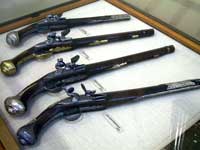
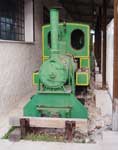
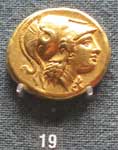
National Historical Museum of Athens, Athens Railway Museum, Numismatics Museum in Athens,
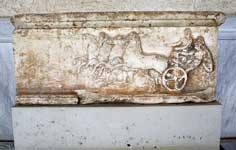

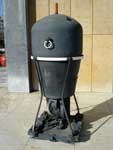
Ancient Agora Museum (Athens), , Epigraphical Museum in Athens, War Museum in Athens,
Athens Municipality
The seven districts of Athens municipality
The municipality of Athens is the most populous in Greece, with a population of 655,780 people (in 2011)[12] and an area of 39 km2 (15 sq mi).[13] The current mayor of Athens is Giorgos Kaminis. It is divided into seven municipal districts. The 7-district division is mainly used for administrative purposes. For Athenians the most popular way of dividing the city proper is through its neighbourhoods such as Pagkrati, Ambelokipi, Exarcheia, Patissia, Ilissia, Petralona, Koukaki and Kypseli, each with its own distinct history and characteristics.
Greater Athens consists of the central municipality of Athens and 34 more municipalities, which are divided in the four peripheral units mentioned above.
Municipalities of Greater Athens
Central Section: 1. City of Athens 2. Dafni 3. Ilioupoli 4. Vyronas 5. Kaisariani 6. Zografou 7. Galatsi 8. Filadelfeia
West Section:
29. Egaleo
30. Agia Varvara
31. Chaidari
32. Peristeri
33. Petroupoli
34. Ilion
35. Agioi Anargyroi – Kamatero
Athens
North Section:
9. Nea Ionia
10. Irakleio
11. Metamorfosi
12. Lykovrysi - Pefki
13. Kifissia
14. Penteli
15. Amarousio
16. Vrilissia
17. Ag. Paraskevi
18. Cholargos - Papagou
19. Chalandri
20. Filothei - Psychiko
South Section: 21. Glyfada 22. Argyroupoli 23. Alimos 24. Agios Dimitrios 25. Nea Smyrni 26. Faliro 27. Kallithea 28. Moschato
The municipalities of Greater Athens along with the municipalities within Greater Piraeus (peripheral unit of Piraeus) form the Athens Urban Area, while the larger metropolitan area includes several additional suburbs and towns surrounding the dense urban area of the Greek capital.
Cityscape
Athens view from Pnyx Hill
Athens view from Areopagus
Architecture
The Academy of Athens.
Zappeion Hall.
The city of Athens contains a variety of different architectural styles, ranging from Greco-Roman, Neo-Classical, to modern. They are often to be found in the same areas, as Athens is not marked by a uniformity of architectural style. Many of the most prominent buildings of the city are either Greco-Roman or neo-classical in styling. Some of the neo-classical structures to be found are public buildings erected during the mid-19th century, under the guidance of Theophil Freiherr von Hansen and Ernst Ziller, and include the Athens Academy, Athens City Hall, Greek Parliament, Old Parliament (1875–1932) (Now the National Historical Museum),[50] University of Athens, and Zappeion Hall.
Beginning in the 1930s, the International style and other architectural movements such as Bauhaus and Art Deco began to exert an influence on almost all Greek architects, and many buildings both public and private were constructed in accordance with these styles. Localities with a great number of such buildings include Kolonaki, and some areas of the centre of the city; neighbourhoods developed in this period include Kypseli.
In the 1950s and 1960s during the vast extension and development of Athens, modern architecture played a very important role. The centre of Athens was largely rebuilt, leading to the demolition of a number of neoclassical buildings. The architects of this era employed materials such as glass, marble and aluminium, while some blended modern and classical elements. After World War II, internationally known architects to have designed and built in the city included Walter Gropius, with his design for the US Embassy, and, amongst others, Eero Saarinen, in his postwar design for the east terminal of the Ellinikon Airport.
Notable Greek architects of the 1930s–1960s included Konstantinos Doxiadis, Dimitris Pikionis, Pericles A. Sakellarios, Aris Konstantinidis and others.
Neighborhoods
Mount Lycabettus at night.
The municipality of Athens, the city center of the Athens Urban Area, is divided into several districts: Omonoia, Syntagma, Exarcheia, Agios Nikolaos, Neapolis, Lykavittos, Lofos Strefi, Lofos Finopoulou, Lofos Filopappou, Pedion Areos, Metaxourgeio, Aghios Kostantinos, Larissa Station, Kerameikos, Psiri, Monastiraki, Gazi, Thission, Kapnikarea, Aghia Irini, Aerides, Anafiotika, Plaka, Acropolis, Pnyka, Makrygianni, Lofos Ardittou, Zappeion, Aghios Spyridon, Pangration, Kolonaki, Dexameni, Evaggelismos, Gouva, Aghios Ioannis, Neos Kosmos, Koukaki, Kynosargous, Fix, Ano Petralona, Kato Petralona, Rouf, Votanikos, Profitis Daniil, Akadimia Platonos, Kolonos, Kolokynthou, Attikis Square, Lofos Skouze, Sepolia, Kypseli, Aghios Meletios, Nea Kypseli, Gyzi, Polygono, Ampelokipoi, Panormou-Gerokomeio, Pentagono, Ellinorosson, Kato Filothei, Ano Kypseli, Tourkovounia-Lofos Patatsou, Lofos Elikonos, Koliatsou, Thymarakia, Kato Patisia, Treis Gefyres, Aghios Eleftherios, Ano Patisia, Kypriadou, Prompona, Aghios Panteleimonas, Pangrati, Goudi, Ilisia, Kaisariani
View of the Ambelokipi district.
Street in Plaka.
Syntagma Square.
Omonoia, Omonoia Square, (Greek: Πλατεία Ομονοίας) is the oldest square in Athens. It is surrounded by hotels and fast food outlets, and contains a train station used by the Athens Metro and the Ilektrikos, appropriately named Omonoia Station. The square often becomes the focus for celebration of sporting victories, as seen after the country's winning of the Euro 2004 and the Eurobasket 2005 tournaments.
Metaxourgeio (Greek: Μεταξουργείο) is a neighborhood of Athens, Greece. The neighborhood is located south of the historical center of Athens, between Kolonos to the east and Kerameikos to the west, and north of Gazi. Metaxourgeio is frequently described as a transition neighborhood. After a long period of abandonment in the late 20th century, the area is acquiring a reputation as an artistic and fashionable neighborhood due to the opening of many art galleries, museums, and trendy restaurants and cafes.[1] Moreover, local efforts to beautify and invigorate the neighborhood have reinforced a budding sense of community and artistic expression. Anonymous art pieces containing quotes and sayings in both English and Ancient Greek have begun springing up throughout the neighborhood, containing statements such as "Art for arts sake" (Τεχνη τεχνης χαριν). Guerilla gardening has also helped to beautify this area, taking advantage of the ample sunshine in Greece.
Psiri and Gazi - The reviving Psiri (Greek: Ψυρρή) neighbourhood – a.k.a. Athens's "meat packing district" – is dotted with renovated former mansions, artists' spaces, and small gallery areas. A number of its renovated buildings also now host a wide variety of fashionable bars, making it a hotspot for the city in the last decade, while a number of live music restaurants known as "rebetadika", after rebetiko, a unique form of music that blossomed in Syros and Athens from the 1920s until the 1960s, are also to be found. Rebetiko is admired by many, and as a result rebetadika are often crammed with people of all ages who will sing, dance and drink till dawn. The Gazi (Greek: Γκάζι) area, one of the latest in full redevelopment, is located around a historic gas factory, now converted into the Technopolis cultural multiplex, and also includes artists' areas, a number of small clubs, bars and restaurants, as well as Athens' nascent "Gay Village". The metro's system recent expansion to the western suburbs of the city has brought easier access to the area since spring 2007, as the blue line now stops at Gazi (Kerameikos station).
Syntagma, Syntagma Square, (Greek: Σύνταγμα/Constitution Square), is the capital's central and largest square, lying adjacent to the Greek Parliament (the former Royal Palace) and the city's most noted hotels. Ermou Street, an approximately one kilometer-long pedestrian road connecting Syntagma Square to Monastiraki, has traditionally been a consumer paradise for both Athenians and tourists. Complete with fashion shops and shopping centres promoting most international brands, it now finds itself in the top 5 most expensive shopping streets in Europe, and the tenth most expensive retail street in the world.[51] Nearby, the renovated Army Fund building in Panepistimiou Street includes the "Attica" department store and several upmarket designer stores.
The Temple of Hephaestus in the central district of Thission.
Plaka, Monastiraki, and Thission - Plaka (Greek: Πλάκα), lying just beneath the Acropolis, is famous for its plentiful neoclassical architecture, making up one of the most scenic districts of the city. It remains a traditionally prime tourist destination with a number of picturesque tavernas, live performances and street salesmen. Nearby Monastiraki (Greek: Μοναστηράκι), for its part, is well known for its string of small shops and markets, as well as its crowded flea market and tavernas specialising in souvlaki. Another district notably famous for its student-crammed, stylish cafés is Theseum or Thission (Greek: Θησείο), lying just west of Monastiraki. Thission is home to the ancient Temple of Hephaestus, standing atop a small hill. This area also has a picturesque 11th Century Byzantine church, as well as a 15th Century Ottoman mosque.
Exarcheia (Greek: Εξάρχεια), located north of Kolonaki, has a mixed reputation as the recent or current location of the city's anarchist scene and as a culturally active student quarter with many cafés, bars and bookshops. Exarcheia is home to the Athens Polytechnic and the National Archaeological Museum; it also contains numerous important buildings of several 20th-century styles: Neoclassicism, Art Deco and Early Modernism (including Bauhaus influences).[CN]
Kolonaki (Greek: Κολωνάκι) is the area, at the base of Lycabettus hill, is full of boutiques catering to well-heeled customers by day, and bars and more fashionable restaurants by night, but at other points also a wide range of art galleries and museums. This is often regarded as one of the more prestigious areas of the capital.
Panoramic view of Kolonaki Square.
.
Suburbs
Urban area of Athens.
The Athens Metropolitan Area consists of 58[14] (excluding the Islands Peripheral Unit municipalities) densely populated municipalities, sprawling around the municipality of Athens (the city center) in virtually all directions. According to their geographic location in relation to the city of Athens, the suburbs are divided into four zones; the northern suburbs (including Ekali, Nea Erythrea, Agios Stefanos, Drosia, Dionysos, Kryoneri, Kifissia, Maroussi, Pefki, Lykovrisi, Heraklio, Glyka Nera, Vrilissia, Melissia, Pendeli, Halandri, Aghia Paraskevi, Psychiko and Filothei); the southern suburbs, (including Kalamaki, Nea Smirni, Agios Dimitrios, Palaio Faliro, Elliniko, Glyfada,, Voula Argyroupoli, Ilioupoli and the southernmost suburb of Vouliagmeni); the eastern suburbs, (including Acharnes, Zografou, Vyronas, Kaisariani, Cholargos and Papagou; and the western suburbs (including Peristeri, Ilion, Egaleo, Petroupoli and Nikaia).
The Athens city coastline, extending from the major commercial port of Piraeus to the southernmost suburb of Varkiza for some 25 km (20 mi),[52] is also connected to the city centre by a tram.
In the northern suburb of Maroussi, the upgraded main Olympic Complex (known by its Greek acronym OAKA) dominates the skyline. The whole area has been redeveloped according to a design by the Spanish architect Santiago Calatrava, with steel arches, landscaped gardens, fountains, futuristic glass, and a landmark new blue glass roof which was added to the main stadium. A second Olympic complex, next to the sea at the beach of Kallithea (Faliron), also features modern stadia, shops and an elevated esplanade. Work is underway to transform the grounds of the old Athens Airport – named Hellinikon – in the southern suburbs, into one of the largest landscaped parks in Europe, to be named the Hellenikon Metropolitan Park.[53]
Many of the southern suburbs (such as Alimos, Palaio Faliro, Elliniko, Voula, Vouliagmeni and Varkiza) host a number of sandy beaches, most of which are operated by the Greek National Tourism Organisation and require an entrance fee, which is not excessive in most cases. Casinos operate on both Mount Parnitha, some 25 km (16 mi)[54] from downtown Athens, (accessible by car or cable car) and the nearby town of Loutraki (accessible by car via the Athens – Corinth National Highway, or the suburban rail service (Proastiakos)).
of Palaio Faliro.
Parks and Zoos
The entrance of the National Gardens, commissioned by Queen Amalia in 1838 and completed by 1840.
Artificial lake in the park of Nea Filadelfia.
Parnitha National Park is punctuated by well-marked paths, gorges, springs, torrents and caves dotting the protected area. Hiking and mountain-biking in all four mountains remain popular outdoor activities for many residents of the city. The National Garden of Athens was completed in 1840 and is a green refuge of 15.5 hectares in the center of the Greek capital. It is to be found between the Parliament and Zappeion buildings, the latter of which maintains its own garden of seven hectares.
Parts of the city centre have been redeveloped under a masterplan called the Unification of Archeological Sites of Athens, which has also gathered funding from the EU to help enhance the project.[55][56] The landmark Dionysiou Aeropagitou street has been pedestrianised, forming a scenic route. The route starts from the Temple of Olympian Zeus at Vasilissis Olgas Avenue, continues under the southern slopes of the Acropolis near Plaka, and finishes just beyond the Temple of Hephaestus in Thiseio. The route in its entirety provides visitors with views of the Parthenon and the Agora (the meeting point of ancient Athenians), away from the busy city centre.
The hills of Athens also provide green space. Lycabettus, Philopappos hill and the area around it, including Pnyx and Ardettos hill, are planted with pines and other trees, with the character of a small forest rather than typical metropolitan parkland. Also to be found is the Pedion tou Areos (Field of Mars) of 27.7 hectares, near National Archaeological Museum.
The biggest zoo of the city is the Attica Zoological Park, a 20-hectare (49-acre) private zoo located in the suburb of Spata. The zoo is home to about 2000 animals representing 400 species, and is open 365 days per year. Smaller zoos exist within public gardens or parks, such as the zoo within the National Garden of Athens.
Demographics
Athens area from space
Athens population distribution
The municipality of Athens has an official Population of 655,780[12] while along with the four peripheral units that make up what is referred to as Greater Athens, had a combined population of 2,625,090. They together with the peripheral unit of Piraeus (Greater Piraeus) make up the dense urban area of Athens which reached a total population of 3,074,160 inhabitants in 2011.[14]
There are some 200,000 Muslims living in Athens.[57]
The ancient site of Athens is centred on the rocky hill of the acropolis. In ancient times the port of Piraeus was a separate city, but it has now been absorbed into forming a part of the Athens Urban Area. The rapid expansion of the city (which continues even today) was initiated in the 1950s and 1960s, because of the transition of Greece from an agricultural to an industrial nation.[58] The expansion is now particularly toward the East and North East (a tendency greatly related to the new Eleftherios Venizelos International Airport and the Attiki Odos, the freeway that cuts across Attica). By this process Athens has engulfed many former suburbs and villages in Attica, and continues to do so. Throughout its long history, Athens has experienced many different population levels. The table below shows the historical population of Athens in recent times.
Year City population Urban population Metro population
1833 4,000[59] – –
1870 44,500[59] – –
1896 123,000[59] – –
1921 (Pre-Population exchange) 473,000[19] – –
1921 (Post-Population exchange) 718,000[59] – –
1971 867,023[60] – –
1981 885,737 – –
1991 772,072 – 3,444,358[61]
2001 745,514[62] 3,165,823[62] 3,761,810[62]
2011 655,780 3,074,160 3,737,550[14]
Details
The large City Center of the Greek capital falls directly within the municipality of Athens, which is the largest in population size in Greece. Piraeus also forms a significant city center on its own, within the Athens Urban Area and being the second largest in population size within it, with Peristeri and Kallithea following.
The Athens Urban Area today, consists of 40 municipalities, 35 of which make up, what is referred to as the Greater Athens municipalities located within 4 peripheral units (peripheral units of: North Athens, West Athens, Central Athens, South Athens); and a further 5, which make up the Greater Piraeus municipalities, located within the peripheral unit of Piraeus as mentioned above. The densely built up urban area of the Greek capital sprawls across 412 km2 (159 sq mi)[13] throughout the Attica Basin and has a total population of 3,074,160 (in 2011).
The Athens Metropolitan Area spans 2,928.717 km2 (1,131 sq mi) within the Attica Periphery and includes a total of 58 municipalities, which are organized in 7 Peripheral Units (those outlined above, along with East Attica and West Attica), having reached a population of 3,737,550 in 2011.
Culture and contemporary life
Main article: Culture of Greece
View of the Roman Agora.
The porch of the Caryatids at the Erechtheum.
The Temple of Olympian Zeus.
A close-up view of the Philopappos Monument.
Archaeological hub
The city is one of the world's main centres of archaeological research. Apart from national institutions, such as Athens University, the Archaeological Society, several archaeological Museums (including the National Archaeological Museum, the Cycladic Museum, the Epigraphic Museum, the Byzantine Museum, as well as museums at the ancient Agora, Acropolis, and Kerameikos), the city is also home to the Demokritos laboratory for Archaeometry as well as several regional and national archaeological authorities that form part of the Greek Department of Culture. Additionally, Athens hosts 17 Foreign Archaeological Institutes which promote and facilitate research by scholars from their respective home countries. As a result, Athens has more than a dozen archaeological libraries and three specialized archaeological laboratories, and is the venue of several hundred specialized lectures, conferences and seminars, as well as dozens of archaeological exhibitions, per year. At any given time, Athens is the (temporary) home to hundreds of international scholars and researchers in all disciplines of archaeology.
Museums
View of the Acropolis Museum.
The National Archaeological Museum in central Athens.
The most important museums of Athens include: The National Archaeological Museum, the largest archaeological museum in the country, and one of the most important internationally, as it contains a vast collection of antiquities; its artifacts cover a period of more than 5,000 years, from late Neolithic Age to Roman Greece; The Benaki Museum with its several branches for each of its collections including ancient, Byzantine, ottoman-era and Chinese art and beyond; The Byzantine and Christian Museum, one of the most important museums of Byzantine art; The Numismatic Museum, housing a great collection of ancient and modern coins; The Museum of Cycladic Art, home to an extensive collection of Cycladic art, including the famous figurines made of white marble; and finally the New Acropolis Museum, opened in 2009, and replacing the old museum on the Acropolis. The new museum has proved considerably popular; almost one million people visited during the summer period June–October 2009 alone. A number of smaller and privately owned museums focused on Greek culture and arts are also to be found.
Tourism
Athens has been a popular destination for travelers since antiquity. Over the past decade, the city's infrastructure and social amenities have improved, in part due to its successful bid to stage the 2004 Olympic Games. The Greek Government, aided by the EU, has funded major infrastructure projects such as the state-of-the-art Eleftherios Venizelos International Airport,[63] the expansion of the Athens Metro system,[55] and the new Attiki Odos Motorway.[55]
Entertainment and performing arts
Aerial view of Athens Olympic Sports Complex.
View of the Odeon of Herodes Atticus.
Athens Planetarium is considered one of the largest and best equipped digital planetaria in the world.
Athens is home to 148 theatrical stages, more than any other city in the world, including the famous ancient Odeon of Herodes Atticus, home to the Athens Festival, which runs from May to October each year.[64][65] In addition to a large number of multiplexes, Athens plays host to a variety of romantic, open air garden cinemas. The city also supports a vast number of music venues, including the Athens Concert Hall (Megaron Moussikis), which attracts world-famous artists all year round.[66] The Athens Planetarium,[67] located in Andrea Syngrou Avenue is one of the largest and best equipped digital planetaria in the world.[68][69]
Sports
Athens has a long tradition in sports and sporting events, being home of the most important clubs in Greek sports and having a large number of sports facilities. The city has also served as a host of several sports events of international notability.
Athens has hosted the Summer Olympic Games twice, in 1896 and 2004. The 2004 Summer Olympics inspired the development of the Athens Olympic Stadium, which has since gained a reputation as one of the most beautiful stadia in the world, and one of its most interesting modern monuments.[70] The biggest stadium in the country, it has hosted two finals of the UEFA Champions League, in 1994 and 2007. The other major stadium of Athens, located in Piraeus area, is the Karaiskakis Stadium, a state-of-the-art sports and entertainment complex, host of the 1971 UEFA Cup Winners' Cup Final. In 2004 Greece's national soccer team won the UEFA Cup Finals in Portugal. They beat the host nation Portugal 1:0.
Athens has hosted the Euroleague final three times, the first in 1985 and second in 1993, both at the Peace and Friendship Stadium, most known as SEF, one of the largest and most attractive indoor arenas in Europe,[71] and the third in 2007 at the Olympic Indoor Hall. A large number of events in other sports such as athletics, volleyball, water polo etc., has also been hosted in the capital's venues.
Athens is home to three prestigious European multi-sport clubs: Olympiacos, Panathinaikos, AEK Athens. In football, Olympiacos have dominated the domestic competitions, Panathinaikos made it to the 1971 European Cup Final, while AEK Athens is the other member of the big three. These clubs also hold prominent basketball departments; Panathinaikos and Olympiacos are among the top powers in European basketball, having won the Euroleague six times and once respectively, with AEK Athens being the first Greek team to win a European trophy in any team sports. Other clubs with great tradition in sports within Athens are Panionios, Panellinios, Ethnikos Piraeus and Maroussi. Athenian clubs have also had significant domestic and international success in other sports. The Athens area encompasses a variety of terrain, notably hills and mountains rising around the city, and the capital is the only major city in Europe to be bisected by a mountain range. Four mountain ranges extend into city boundaries and thousands of miles of trails crisscross the city and neighbouring areas, providing exercise and wilderness access on foot and bike. Beyond Athens and across the county a great variety of outdoor activities are available and popular, including skiing, rock climbing, hang gliding and windsurfing. Numerous outdoor clubs serve these sports, including the Athens Chapter of the Sierra Club, which leads over 4,000 outings annually in the area.
Education
The Propylaea, part of the “Trilogy” of Theofil Hansen, serves as the ceremony hall and rectory of the National and Kapodistrian University of Athens.
The entrance of the National Library of Greece.
Located on Panepistimiou Street, the old campus of the University of Athens, the National Library, and the Athens Academy form the "Athens Trilogy" built in the mid-19th century. Most of the university's workings have been moved to a much larger, modern campus located in the eastern suburb of Zografou. The second higher education institution in the city is the Athens Polytechnic School, found in Patission Street. This was the location where on 17 November 1973, more than 13 students were killed and hundreds injured inside the university during the Athens Polytechnic uprising,[72] against the military junta that ruled the nation from 21 April 1967 until 23 July 1974. Another notable institution in Patission Street is the Athens University of Economics and Business, which is the oldest business school in Greece and the Agricultural University of Athens which lies at the west of city's center.
Environment
Recycling machine in Athens.
By the late 1970s, the pollution of Athens had become so destructive that according to the then Greek Minister of Culture, Constantine Trypanis, "...the carved details on the five the caryatids of the Erechtheum had seriously degenerated, while the face of the horseman on the Parthenon's west side was all but obliterated."[73] A series of strict measures taken by the authorities of the city throughout the 1990s resulted in the improvement of air quality; the appearance of smog (or nefos as the Athenians used to call it) has become less common. Widespread measures taken by the Greek authorities throughout the 1990s have improved the quality of air over the Attica Basin. Nevertheless, air pollution still remains an issue for Athens, particularly during the hottest summer days. In late June 2007,[74] the Attica region experienced a number of brush fires,[74] including a blaze that burned a significant portion of a large forested national park in Mount Parnitha,[75] considered critical to maintaining a better air quality in Athens all year round.[74] Damage to the park has led to worries over a stalling in the improvement of air quality in the city.[74]
The major waste management efforts undertaken in the last decade (particularly the plant built on the small island of Psytalia) have improved water quality in the Saronic Gulf, and the coastal waters of Athens are now accessible again to swimmers. In January 2007, Athens faced a waste management problem when its landfill near Ano Liosia, an Athenian suburb, reached capacity.[76] The crisis eased by mid-January when authorities began taking the garbage to a temporary landfill.[76]
Transport
Interchange at the Attiki Odos airport entrance.
Highway interchange in the northern suburb of Marousi.
Exhibition of antiquities in the luxurious Syntagma Station of the Athens Metro.
The Athens Mass Transit System consists of a large bus fleet, a trolleybus fleet that mainly serves the downtown area (city center), the city's Metro, a tram line connecting the southern suburbs to the city centre,[77] and the Athens commuter rail service.[78]
Athens Metro
Main article: Athens Metro
The Athens Metro is more commonly known in Greece as the Attiko Metro (Greek: Αττικό Mετρό). While its main purpose is transport, it also houses Greek artifacts found during construction of the system.[79] The Athens Metro supports an operating staff of 387 and runs two of the three metro lines;[80] its two lines (red and blue, also referred to as lines 2 and 3) were constructed largely during the 1990s, and the initial sections opened in January 2000, while the lines run entirely underground. The metro network operates a fleet of 42 trains consisting of 252 cars,[80] with a daily occupancy of 550,000 passengers.[80]
The Red Line (line 2) runs from Aghios Antonios to Aghios Dimitrios and covers a distance of 11.6 km (7 mi).[80] Extensions to both these lines are under construction, most notably westwards to Piraeus, southwards to the Old Hellinikon Airport East Terminal (the future Metropolitan Park), and eastward toward the easternmost suburb of Aghia Paraskevi. The eastern part is actually no extension per se, but rather an opening of new stations between the Ethniki Amyna and Doukissis Plakentias stations. The spring 2007 extension from Monastiraki westwards, to Egaleo, connected some of the main night life hubs of the city, namely the ones of Gazi (Kerameikos station) with Psirri (Monastiraki station) and the city centre (Syntagma station).
The Blue Line (line 3) runs from the western suburbs, namely the Egaleo station, through the central Monastiraki and Syntagma stations to Doukissis Plakentias avenue in the northeastern suburb of Halandri, covering a distance of 16 km (10 mi),[80] then ascending to ground level and reaching Eleftherios Venizelos International Airport, using the Suburban Railway infrastructure and extending its distance to 39 km (24 mi).[80]
Electric railway (ISAP)
Main article: ISAP
An ISAP train (Green Line) passes by the Stoa of Attalos in central Athens.
Not run by the Athens Metro, is the ISAP (Greek: ΗΣΑΠ), the Electric Railway Company line, which for many years served as Athens' primary urban rail transport. This is today the Green Line (line 1) of the Athens Metro network as shown on maps, and unlike the red and blue routes running entirely underground, ISAP runs either above-ground or below-ground at different sections of its journey. The same operator run the original metro line from Piraeus to Kifisia; serving 22 stations,[81] with a network length of 25.6 km (15.9 mi),[81] an operating staff of 730 and a fleet of 44 trains and 243 cars.[81] ISAP's occupancy rate numbers of 600,000 passengers daily.[81]
The historic Green Line, is 25.6 km (16 mi) long, serving 24 stations, It forms the oldest line of the Athens metro network and for the most part runs at ground level,[82] connecting the port of Piraeus with the northern suburb of Kifissia. The line is set to be extend to Agios Stefanos, a suburb located 23 km (14 mi)[CN] to the north of Athens, reaching to 36 km (22 mi).[CN]
Commuter/Suburban rail (Proastiakos)
Main article: Proastiakos
Suburban Rail.
The Athens commuter rail service, referred to as the "Proastiakós", connects Eleftherios Venizelos International Airport to the city of Corinth, 80 km (50 mi)[83] west of Athens, via Larissa station, the city's central rail station and the port of Piraeus. The service is sometimes considered the fourth line of the Athens Metro. The commuter/suburban rail network currently extends to a length of 120 km (75 mi),[83] and is expected to stretch to 281 km (175 mi) by 2010.[83] The Proastiakos will be extended to Xylokastro west of Athens and Chalkida.[83]
Altogether the urban and suburban railway system is managed by three different companies; namely ISAP (line 1),[84] Attiko Metro (lines 2 & 3) and Proastiakós (line 4).
Buses
Bus in Athens
Ethel (Greek: ΕΘΕΛ) (Etaireia Thermikon Leoforeion), or Thermal Bus Company, is the main operator of buses in Athens. Its network consists of about 300 bus lines which span the entire Attica Basin,[85] with an operating staff of 5,327, and a fleet of 1,839 buses.[86] Of those 1,839 buses 416 run on compressed natural gas,[86] making up the largest fleet of natural gas-powered buses in Europe.[87]
Besides being served by a fleet of natural-gas and diesel buses, the Athens metropolitan area is also served by trolleybuses — or electric buses, as they are referred to in the name of the operating company. The network operated by Electric Buses of the Athens and Pireaus Region, or ILPAP (Greek: ΗΛΠΑΠ), consists of 22 lines with an operating staff of 1,137.[88] All of the 366 trolleybuses are equipped to enable them to run on diesel in case of power failure.[88]
Tram
Athens Tram.
Athens Tram SA operates a fleet of 35 vehicles,[89] which serve 48 stations,[89] employ 345 people with an average daily occupancy of 65,000 passengers.[89] The tram network spans a total length of 27 km (17 mi) and covers ten Athenian suburbs.[89] This network runs from Syntagma Square to the southwestern suburb of Palaio Faliro, where the line splits in two branches; the first runs along the Athens coastline toward the southern suburb of Voula, while the other heads toward the Piraeus district of Neo Faliro. The network covers the majority of the Saronic coastline.[90] Further extensions are planned towards the major commercial port of Piraeus.[89] The expansion to Piraeus will include 12 new stations, increase the overall length of the tram by 5.4 km (3 mi), and increase the overall transportation network.[91]
Eleftherios Venizelos International Airport
Main article: Athens International Airport
Eleftherios Venizelos International Airport Control tower.
Athens is served by the state-of-the-art Eleftherios Venizelos International Airport (AIA) located near the town of Spata, in the eastern Messoghia plain, some 35 km (22 mi) east of Athens.[92] The airport was awarded the "European Airport of the Year 2004" Award.[93] Intended as an expandable hub for air travel in southeastern Europe, it was constructed in a record 51 months costing 2.2 billion euros, and employing a staff of 14,000.[93] An express bus service is provided, connecting the airport to the metro system, and 2 express bus services connect the airport to the port at Piraeus and the city centre respectively. Eleftherios Venizelos accommodates 65 landings and take-offs per hour,[92] with its 24 passenger boarding bridges,[92] 144 check-in counters and broader 150,000 m2 (1,614,587 sq ft) main terminal,[92] and a commercial area of 7,000 m2 (75,347 sq ft) which includes cafes, duty-free shops,[93] and a small museum. In 2007, the airport handled 16,538,390 passengers, an increase of 9.7% over the previous year of 2006.[94] Of those 16,538,390 passengers, 5,955,387 passed through the airport for domestic flights,[94] and 10,583,003 passengers travelled through for international flights.[94] Beyond the dimensions of its passenger capacity, AIA handled 205,294 total flights in 2007, or approximately 562 flights per day.[95]
Railways, highways and ferry connections
Athens is the hub of the country's national railway system (OSE), connecting the capital with major cities across Greece and abroad (Istanbul, Sofia, and Bucharest). Ferries departing from the major port of Piraeus connect the city to the numerous Greek islands of the Aegean Sea. There are two main highways; one heading towards the western city of Patras in Peloponessus (GR-8A, E94) and the other heading to the north, towards Greece's second largest city, Thessaloniki (GR-1, E75). From 2001 to 2004, a ring road toll-motorway (Attiki Odos) was gradually completed, extending from the western industrial suburb of Elefsina all the way to the Athens International Airport. The Ymittos Periphery Highway is a separate section of Attiki Odos connecting the eastern suburb of Kaisariani to the northeastern town of Glyka Nera; this is where it meets the main part of the ring road. The span of the Attiki Odos in all is 65 km (40 mi).[96]
Olympic Games
Poster of 1896 Summer Olympics.
1896 Summer Olympics
Main article: 1896 Summer Olympics
Spyridon Louis entering the Kallimarmaron Stadium at the end of the marathon.
1896 brought forth the revival of the modern Olympic Games, by Frenchman Pierre de Coubertin. Thanks to his efforts, Athens was awarded the first modern Olympic Games. In 1896, the city had an approximate population of 123,000[59] and the event helped boost the city's international profile. Of the venues used for these Olympics, the Kallimarmaro Stadium, and Zappeion were most crucial. The Kallimarmaro is a replica of the ancient Athenian stadiums, and the only major stadium (in its capacity of 60,000) to be made entirely of white marble from Mount Penteli, the same material used for construction of the Parthenon.
1906 Summer Olympics
Main article: 1906 Intercalated Games
The 1906 Summer Olympics, or the 1906 Intercalated games, were held very successfully in Athens. The intercalated competitions were intermediate games to the internationally organized olympics, and were meant to be organized in Greece. This idea later lost support from the IOC and these games were not made permanent.
Archery matches in Kallimarmaron Stadium during the 2004 Olympic Games.
2004 Summer Olympics
Main article: 2004 Summer Olympics
Athens was awarded the 2004 Summer Olympics on 5 September 1997 in Lausanne, Switzerland, after having lost a previous bid to host the 1996 Summer Olympics, to Atlanta, United States.[15] It was to be the second time Athens would have the honour of hosting the games, following the inaugural event of 1896. After an unsuccessful bid in 1990, the 1997 bid was radically improved, including an appeal to Greece's Olympic history. In the last round of voting, Athens defeated Rome with 66 votes to 41.[15] Prior to this round, the cities of Buenos Aires, Stockholm and Cape Town had already been eliminated from competition, having received fewer votes.[15]
The Olympic Flame at the opening ceremony of the 2004 Olympic Games, conceived by the avant-garde choreographer Dimitris Papaioannou.
During the first three years of preparations, the International Olympic Committee had repeatedly expressed some concern over the speed of construction progress for some of the new Olympic venues. In 2000 the Organising Committee's president was replaced by Gianna Angelopoulos-Daskalaki, who was the president of the original Bidding Committee in 1997. From that point on, preparations continued at a highly accelerated, almost frenzied pace.
Although the heavy cost was criticized, estimated at $1.5 billion, as is usually the case with most Olympic cities, Athens was literally transformed into a more functional city that enjoys state-of-the-art technology both in transportation and in modern urban development.[97] Some of the finest sporting venues in the world were created in the city, all of which were fully ready for the games. The games welcomed over 10,000 athletes from all 202 countries.[97]
The 2004 Games were judged a huge success, as both security and organization were exceptionally good, and only a few visitors reported minor problems mainly concerning accommodation issues. The 2004 Olympic Games were described as Unforgettable, dream Games, by IOC President Jacques Rogge for their return to the birthplace of the Olympics, and for superbly meeting the challenges of holding the Olympic Games.[97] The only observable problem was a somewhat sparse attendance of some early events. Eventually, however, a total of more than 3.5 million tickets were sold, which was higher than any other Olympics with the exception of Sydney (more than 5 million tickets were sold there in 2000).[98]
In 2008 it was reported that almost all of the Olympic venues had fallen into varying states of disrepair: according to those reports, 21 of the 22 facilities built for the games had either been left abandoned or are in a state of dereliction, with several squatter camps having sprung up around certain facilities, and a number of venues afflicted by vandalism, graffiti or strewn with rubbish.[99][100][101] These claims, however, are disputed and likely to be inaccurate, as most of the facilities used for the Athens Olympics are either in use or in the process of being converted for post-Olympics use. The Greek Government has created a corporation, Olympic Properties SA, which is overseeing the post-Olympics management, development and conversion of these facilities, some of which will be sold off (or have already been sold off) to the private sector,[102] while other facilities are still in use just as during the Olympics, or have been converted for commercial use or modified for other sports.[103]
International relations
See also: List of twin towns and sister cities in Greece
Twin towns – Sister cities
Athens is twinned with:
United States Athens, Georgia, United States
Spain Barcelona, Spain (1999)[104]
China Beijing, People's Republic of China (2005)[105]
Lebanon Beirut, Lebanon[106]
Palestinian territories Bethlehem, Palestinian Territories (1986)[107][108]
Romania Bucharest, Romania[109]
United States Chicago, United States (1997)[110]
Peru Cusco, Peru (1991)[111]
Turkey Istanbul, Turkey[112]
United States Los Angeles, United States (1984)[113]
Russia Moscow, Russia[114]
Italy Naples, Italy[115]
Cyprus Nicosia, Cyprus (1988)[116]
South Korea Seoul, South Korea (2006)[117]
Albania Tirana, Albania[118]
United States Washington, D.C., United States (2000)[119]
Armenia Yerevan, Armenia (1993)[120]
Partnerships
Serbia Belgrade, Serbia (1966)[121]
France Paris, France (2000)[122]
Colombia Santiago de Cali, Colombia
Other locations named after Athens
United States United States
Athens, Alabama (pop. 24,234)
Athens, Arkansas[123]
Athens, California
West Athens, California (pop. 9,101)
Athens, Georgia (pop. 114,983)
Athens, Illinois (pop. 1,726)
New Athens, Illinois (pop. 2,620)
New Athens Township, St. Clair County, Illinois (pop. 2,620)
Athens, Indiana
Athens, Kentucky
Athens, Louisiana (pop. 262)
Athens Township, Jewell County, Kansas (pop. 74)
Athens, Maine (pop. 847)
Athens, Michigan (pop. 1,111)
Athens Township, Michigan (pop. 2,571)
Athens, Minnesota
Athens Township, Minnesota (pop. 2,322)
Athens, Mississippi
Athens (town), New York (pop. 3,991)
Athens (village), New York (pop. 1,695)
Athens, Ohio (pop. 21,909)
Athens County, Ohio (pop. 62,223)
Athens Township, Athens County, Ohio (pop. 27,714)
Athens Township, Harrison County, Ohio (pop. 520)
New Athens, Ohio (pop. 342)
Athena, Oregon (pop. 1270)
Athens, Pennsylvania (pop. 3,415)
Athens Township, Bradford County, Pennsylvania (pop. 5,058)
Athens Township, Crawford County, Pennsylvania (pop. 775)
Athens, Tennessee (pop. 13,220)
Athens, Texas (pop. 11,297)
Athens, Vermont (pop. 340)
Athens, West Virginia (pop. 1,102)
Athens, Wisconsin (pop. 1,095)
Canada Canada
Athens Township, Ontario (pop. 3,086)
Costa Rica Costa Rica
Atenas (pop. 7,716)
Atenas Canton (pop. 23,743)
Germany Germany
Athenstedt, Saxony-Anhalt (pop. 431)
Ukraine Ukraine
Afini (Zoria – Зоря), Donetsk
See also
Parthenon
Acropolis of Athens
Classical Greece
2004 Summer Olympics
1896 Summer Olympics
Eurovision Song Contest 2006
Hellenic civilization
Large Cities Climate Leadership Group
List of museums in Greece
Panteion University of Athens
Politics of Greece
Hellenic Parliament
Peloponnesian War
Age of Pericles
Greco-Persian Wars
Democracy
National Library of Greece
Athens University
Academy of Athens
National Archaeological Museum, Athens
National Technical University of Athens
Agricultural University of Athens
Athens University of Economics and Business



|
Mayor of Athens Anargyros Petrakis | Angelos Gerontas | Dimitrios Kallifronas | Dimitrios Misaraliotis | Spyridon Benizelos | Nikolaos Zacharitsas | Ioannis Koniaris | Konstantinos Galatis | Georgios Skoufos | Emmanuel Koutsikaris | Periklis Zacharitsas | Panagis Kyriakos | Dimitrios Soutsos | Thrasyvoulos Papalexandris | Timoleon Philimon | Michail Melas | Dimitrios Silyvriotis | Lampros Kallifronas | Spyridon Merkouris | Emmanuel Benakis | Georgios Tsochas | Spyridon Patsis | Kostas Kotzias | Amvrosis Plytas | Konstantinos Mermigkas | Angelos Georgatos | Aristidis Skliros | Ioannis Pitsikas | Dimitrios Skouzes | Antonios Ragkousis | Konstantinos Nikolopoulos | Konstantinos Deligiannis | Pausanias Katsotas | Phokion Theodoropoulos | Alexandros Magriplis| Angelos Tsoukalas | Ioannis Papakonstantinou | Georgios Plytas | Dimitrios Ritsos | Konstantinos Daras | Ioannis Papatheodorou | Dimitris Beis | Miltiadis Evert | Nikolaos Giatrakos | Antonis Tritsis | Leonidas Kouris | Dimitris Avramopoulos | Dora Bakoyanni | Theodoros Bechrakis | Nikitas Kaklamanis| ... |
|
|
Athens neighborhoods Akadimia | Akadimia Platonos | Acropolis | Ampelokipoi | Anafiotika | Ano Petralona | Asyrmatos | Asteroskopeio | Attiki | Dafni | Ellinoroson | Exarcheia | Gazi | Gyzi | Goudi | Gouva | Ilissia | Kallimarmaro | Kato Petralona | Keramikos | Kolokynthou | Kolonaki | Kolonos | Koukaki | Kypseli | Lykavittos | Makrygianni | Metaxourgeio | Mets | Monastiraki | Nea Filothei | Neapoli | Neos Kosmos | Omonoia | Pangrati | Patisia | Pedion tou Areos | Petralona | Plaka | Polygono | Profitis Daniil | Profitis Ilias | Psyri | Rizoupoli | Rouf | Sepolia | Treis Gefyres | Thiseio | Votanikos | |
References
^ Wells, John C. (1990). Longman pronunciation dictionary. Harlow, England: Longman. p. 48. ISBN 0582053838. entry "Athens"
^ "Contents and Principles of the Programme of Unification of the Archaeological Sites of Athens". Hellenic Ministry of Culture. www.yppo.gr. Retrieved 200–12–31.
^ CNN & Associated Press (16 January 1997). "Greece uncovers 'holy grail' of Greek archeology". CNN.com. Archived from the original on 6 December 2007. Retrieved 28 March 2007.
^ "Athens". Retrieved 31 December 2008. "Ancient Greek Athenai, historic city and capital of Greece. Many of classical civilization’s intellectual and artistic ideas originated there, and the city is generally considered to be the birthplace of Western civilization"
^ BBC History on Greek Democracy – Accessed on 26 January 2007
^ Encarta: Ancient Greece[dead link] – Retrieved on 26 January 2007. Archived 2009-10-31.
^ "The World According to GaWC 2008". Globalization and World Cities Study Group and Network (GaWC) based at the geography department of Loughborough University. 2008. Retrieved 21 April 2009.
^ "City Mayors: World's richest cities by purchasing power". City Mayors. 2008. Retrieved 12 May 2008.
^ "City Mayors: Cost of living – The world's most expensive cities". City Mayors. 2008. Retrieved 26 December 2008.
^ Hellenic Statistical Authority " PRESS RELEASE:Publication of provisional results of the 2011 Population Census", Hellenic Statistical Authority (EL.STAT.), July 22, 2011, accessed August 14, 2011.
^ Athens Facts (2011 [last update]). "Athens Facts & Figures". aviewoncities.com. Retrieved 17 June 2011. "796 442"
^ Cite error: Invalid <ref> tag; no text was provided for refs named population; see Help:Cite errors/Cite error references no text
^ a b c d e "Characteristics". Hellenic Interior Ministry. www.ypes.gr. Archived from the original on 4 January 2007. Retrieved 6 January 2007.
^ a b c d "ΕΛΣΤΑΤ Απογραφη 2011". www.statistics.gr. Retrieved 2011-08-22.
^ a b c d CNN & Sports Illustrated (5 September 1997). "Sentiment a factor as Athens gets 2004 Olympics". sportsillustrated.cnn.com. Retrieved 28 March 2007.
^ As for example in Od.7.80
^ "v4.ethnos.gr – Οι πρώτοι... Αθηναίοι – τεχνες , πολιτισμος". Ethnos.gr. Retrieved 25 January 2010.
^ S. Immerwahr, The Athenian Agora XII: the Neolithic and Bronze Ages, Princeton 1971
^ a b c d Tung, Anthony (2001). "The City the Gods Besieged". Preserving the World's Great Cities: The Destruction and Renewal of the Historic Metropolis. New York: Three Rivers Press. p. 266. ISBN 0-609-80815-X.
^ Iakovides, S. 1962. 'E mykenaïke akropolis ton Athenon'. Athens.
^ Osborne, R. 1996, 2009. Greece in the Making 1200 – 479 BC.
^ a b "Focus on Athens". UHI Quarterly Newsletter, Issue 1, May 2009, page 2. www.urbanheatisland.info. Retrieved 18 March 2011.
^ "Welcome!!!". Parnitha-np.gr. Retrieved 10 June 2009.
^ "Daily Report on Air Pollution Levels". Hellenic Ministry of the Environment and Public Works. www.minenv.gr. Retrieved 26 January 2007.
^ Founda D. (2011). "Evolution of the air temperature in Athens and evidence of climatic change: A review". Advances in Bulding Energy Research, 5,1, 7-41, http://www.ingentaconnect.com/content/earthscan/aber/2011/00000005/00000001/art00001.
^ visited may 6, 2011
^ Κωνσταντίνος Μαυρογιάννης, Αθήναι (1981).Παρατηρήσεις επί του κλίματος των Αθηνών και της ενεργείας αυτού επί της ζωϊκής οικονομίας σελ 29.
^ http://www.eib.org/attachments/pipeline/20090584_eia_el.pdf
^ Giannopoulou K., Livada I., Santamouris M., Saliari M., Assimakopoulos M., Caouris Y.G. (2011). "On the characteristics of the summer urban heat island in Athens, Greece". Sustainable Cities and Society, 1, pp. 16-28.
^ "European Space Agency to help Athens become bearable in summer". Retrieved 17 April 2010.
^ Giannakopoulos C., Hatzai M., Kostopoulou E., McCarty M., Goodess C. (2010). "The impact of climate change and urban heat islands on the occurrence of extreme events in cities. The Athens case". Proc. of the 10th International Conference on Meteorology, Climatology and Atmospheric Physics, Patras, Greece, May 25th–28th, 2010, pp. 745–752.
^ a b "European Space Agency ESA helps make summer in the city more bearable". Retrieved 7 November 2010.
^ a b Katsoulis B.D., Theoharatos G.A. (1985). "Indications of the Urban Heat Island in Athens, Greece". Journal of Applied Meteorology, vol. 24, Issue 12, pp.1296–1302
^ Stathopoulou M., Cartalis C., Andritsos A. (2005)."Assessing the thermal environment of major cities in Greece". International Conference "Passive and Low Energy Cooling for the Built Environment", May 2005, Santorini, Greece, pp. 108–112.
^ Kassomenos P.A. and Katsoulis B.D. (2006). "Mesoscale and macroscale aspects of the morning Urban Heat Island around Athens, Greese", Meteorology and Atmospheric Physics, 94, pp. 209–218.
^ Santamouris M., Papanikolaou N., Livada I., Koronakis I., Georgakis A., Assimakopoulos D.N. (2001). "On the impact of urban climate on the energy consumption of buildings". Solar Energy, 70 (3): pp. 201–216.
^ Santamouris M. (1997). "Passive Cooling and Urban Layout". Interim Report, POLIS Research Project, European Commission, Directorate General for Science, Research and Development.> and human wellbeing and health.
^ Santamouris M., Papanikolaou I., Livada I., Koronakis C., Georgakis C, Assimakopoulos D.N. (2001). "On the impact of Urban Climate to the Energy Consumption of Buildings". Solar Energy, 70, 3, pp. 201–216.
^ Katsoulis B. (1987). "Indications of change of climate from the Analysis of air temperature time series in Athens, Greece". Climatic Change, 10, 1, pp- 67–79.
^ Repapis C. C, Metaxas D. A. (1985). "The Possible influence of the urbanization in Athens city on the air temperature climatic fluctuations at the National Observatory". Proc. of the 3rd Hellenic-British Climatological Congress, Athens, Greece 17–21 April 1985, pp.188–195.
^ Philandras C.M, Metaxas D.A., Nastos P.T. (1999). "Climate variability and Urbanization in Athens". Theoretical and Applied Climatology, vol. 63, Issue 1–2, pp.65–72.
^ Philandras C.M, Nastos P.T. (2002). "The Athens urban effect on the air temperature time series of the National Observatory of Athens and New Philadelphia stations". Proc. of the 6th Hellenic Conference on Meteorology, Climatology and Atmospheric Physics, Ioannina Greece, 25–28 September 2002, pp.501–506.
^ Repapis C.C., Philandras C.M., Kalabokas P.D., Zerefos C.S. (2007). "Is the last years abrupt warming in the National Observatory of Athens records a Climate Change Manifestation?". Global NEST Journal, Vol 9, No 2, pp. 107–116.
^ Livada I., Santamouris M., Niachou K., Papanikolaou N., Mihalakakou G. (2002). "Determination of places in the great Athens area where the heat island effect is observed". Theoretical and Applied Climatology, 71, Numbers 3–4, 219–230.
^ "Europe's highest temperature". Retrieved 3 April 2009.
^ "Monthly bulletins", N.O.A, web: [1].
^ "Weather Information for Athens".
^ "Climatological Information for Athens, Greece" – Hong Kong Observatory
^ Kallikratis reform law textPDF
^ Hellenic Ministry of Culture: The Old Parliament Building[dead link] – Retrieved 16 February 2007
^ "Cushman & Wakefield – Global real estate solutions – News & Events". Cushwake.com. 25 October 2006. Retrieved 21 March 2009.
^ "Distance between Piraeus (Attiki) and Varkiza (Piraios Nomos) (Greece)". Distancecalculator.globefeed.com. 9 December 2007. Retrieved 9 June 2009.
^ "Hellenikon Metropolitan Park Competition". Hellenic Ministry of the Environment and Public Works. www.minenv.gr. Retrieved 3 January 2007.[dead link]
^ "Europe | Greek forest fire close to Athens". BBC News. 29 June 2007. Retrieved 9 June 2009.
^ a b c "Olympic Games 2004: five major projects for Athens". European Union Regional Policy. ec.europa.eu. Retrieved 5 April 2007.
^ "Eaxa :: Ενοποιηση Αρχαιολογικων Χωρων Αθηνασ Α.Ε". Astynet.gr. Retrieved 21 March 2009.
^ "Athens Muslims to get a mosque", BBC News, July 18, 2006
^ Greek Tourist Organizer – Retrieved on 6 January 2007
^ a b c d e Tung, Anthony (2001). "The City of the Gods Besieged". Preserving the World's Great Cities:The Destruction and Renewal of the Historic Metropolis. New York: Three Rivers Press. pp. 260, 263, 265. ISBN 0-609-80815-X.
^ "World Gazetter City Pop:Athens". www.world-gazetter.com. Retrieved 2011-06-16.
^ "World Gazetter Metro Pop:Athens". www.world-gazetter.com. Retrieved 2011-06-16.
^ a b c "Population of Greece". General Secretariat Of National Statistical Service Of Greece. www.statistics.gr. 2001. Archived from the original on 1 July 2007. Retrieved 2 August 2007.
^ "AIA: Finance". Athens International Airport, S.A.. www.AIA.gr. Retrieved 5 April 2007.
^ "Home Page". Urban Audit. Retrieved 21 March 2009.
^ "Athens – Epidaurus Festival 2008". Greekfestival.gr. Retrieved 21 March 2009.
^ "Megaron Events Chart". Megaron.gr. 26 October 1997. Retrieved 21 March 2009.[dead link]
^ "Ίδρυμα Ευγενίδου. Εκπαιδευτικό Κοινωφελές Ίδρυμα" (in (Greek)). Eugenfound.edu.gr. Retrieved 21 March 2009.
^ "ΙΔΡΥΜΑ ΕΥΓΕΝΙΔΟΥ 1954 / Ιστορικό" (in (Greek)). Eugenfound.edu.gr. Retrieved 25 October 2009.
^ "Athens Eugenides Planetarium". Barco. Retrieved 2011-06-16.
^ "Athens 21st Century – Athens Olympic Stadium". athens-today.com. Retrieved 26 December 2008.
^ "Athens 21st Century – The Olympic Coastal Complex". athens-today.com. Retrieved 26 December 2008.
^ "1973: Army deposes 'hated' Greek president". BBC News. 25 November 1973. Retrieved 22 March 2009.
^ "Acropolis: Threat of Destruction". Time Magazine (Time.com). 31 January 1977. Retrieved 3 April 2007.
^ a b c d Kitsantonis, Niki (16 July 2007). "As forest fires burn, suffocated Athens is outraged". International Herald Tribune. Retrieved 3 February 2008.
^ "Συνέντευξη Τύπου Γ. Σουφλιά για την Πάρνηθα" (in Greek) (.doc) (Press release). Hellenic Ministry for the Environment, Physical Planning, & Public Works. 18 July 2007. Retrieved 15 January 2008. "Συνολική καμένη έκταση πυρήνα Εθνικού Δρυμού Πάρνηθας: 15.723 (Σύνολο 38.000)"
^ a b "Rot sets in as Athens's trash problem mounts". 30 January 2007. Retrieved 10 February 2008.
^ "Tram Sa". Tramsa.gr. Retrieved 5 January 2009.
^ "Προαστιακός". Proastiakos.gr. Retrieved 21 March 2009.
^ "Athens Metro". Hellenic Ministry of Culture. www.culture.gr. Archived from the original on 7 December 2006. Retrieved 26 January 2007.
^ a b c d e f "Athens Urban Transport Network in Facts and Figures (pdf) page 15". OASA. www.oasa.gr. Retrieved 4 February 2007.[dead link]
^ a b c d "Athens Urban Transport Network in Facts and Figures (pdf) page 9". OASA. www.oasa.gr. Retrieved 4 February 2007.[dead link]
^ "ISAP – Athens Piraeus Electric Railways". Isap.gr. Retrieved 9 June 2009.
^ a b c d "Proastiakos". Proastiakos.gr. Retrieved 9 June 2009.
^ "ΗΣΑΠ". Isap.gr. Retrieved 21 March 2009.
^ "Athens Urban Transport Network in Facts and Figures (pdf) page 5". OASA. www.oasa.gr. Retrieved 28 January 2007.[dead link]
^ a b "Athens Urban Transport Network in Facts and Figures (pdf) page 6". OASA. www.oasa.gr. Retrieved 28 January 2007.[dead link]
^ Ilias Tatsiopoulos & Georgios Tziralis. "New, Post-Olympics Athens" (PDF). www.minpress.gr (Secretariat General of Communication – Secretariat General of Information): p. 79. Retrieved 23 August 2008.[dead link]
^ a b "Athens Urban Transport Network in Facts and Figures (pdf) page 11". OASA. www.oasa.gr. Retrieved 28 January 2007.[dead link]
^ a b c d e "Tram Sa". Tramsa.gr. Retrieved 25 October 2009.
^ "Athens Urban Transport Network in Facts and Figures (pdf) page 13". OASA. www.oasa.gr. Retrieved 28 January 2007.[dead link]
^ "Tram Sa". Tramsa.gr. Retrieved 25 October 2009.
^ a b c d "Athens International Airport: Facts and Figures". Athens International Airport. www.aia.gr. Retrieved 11 February 2007.
^ a b c "Athens International Airport: Airport Profile". Athens International Airport. www.aia.gr. Retrieved 11 February 2007.
^ a b c "Athens International Airport: Passenger Traffic Development 2007". Athens International Airport. Retrieved 6 February 2008.
^ "Athens International Airport: Air Traffic Movements Development 2007". Athens International Airport. Retrieved 6 February 2008.
^ Aodos.gr[dead link]
^ a b c "Athens bids farewell to the Games". CNN (CNN.com). 30 August 2004. Retrieved 29 March 2007.
^ Athens News Agency (27 August 2004). "Olympic ticket sales officially top 3.5-million mark". Embassy of Greece. Retrieved 30 March 2007.
^ Malone, Andrew (18 July 2008). "Abandoned, derelict, covered in graffiti and rubbish: what is left of Athens' £9billion Olympic 'glory'". London: The Daily Mail. Retrieved 25 August 2008.
^ Rogers, Martin. "Beijing trumps Athens ... and then some". Sports.yahoo.com. Retrieved 21 March 2009.
^ Itano, Nicole (21 July 2008). "As Olympic Glow Fades, Athens Questions $15 Billion Cost". Csmonitor.com. Retrieved 21 March 2009.
^ "After The Party: What happens when the Olympics leave town". London: Independent.co.uk. 19 August 2008. Retrieved 21 March 2009.
^ Jul 30, 2008 (30 July 2008). "Four years after Athens Greeks have Olympics blues". Afp.google.com. Retrieved 21 March 2009.
^ "Barcelona internacional – Ciutats agermanades" (in Spanish). © 2006–2009 Ajuntament de Barcelona. Retrieved 13 July 2009.
^ "Beijing Sister Cities". City of Beijing. www.ebeijing.gov.cn. Retrieved 3 January 2007.
^ "Twinnings of the city". City of Beirut. www.beirut.gov.lb. Retrieved 25 January 2008.[dead link]
^ "Twinning with Palestine". Twinning With Palestine. Retrieved 26 January 2008.
^ "::Bethlehem Municipality::". www.bethlehem-city.org. Retrieved 10 October 2009.
^ "Academy of Economic Studies – Short History of Bucharest". Bucharest University of Economics. Retrieved 1 August 2008.[dead link]
^ "Chicago Sister Cities". City of Chicago. www.chicagosistercities.com. Retrieved 3 January 2007.
^ "Ciudades Hermanas" (in Spanish). Municipalidad del Cusco. www.municusco.gob.pe. Retrieved 25 January 2008.
^ Erdem, Selim Efe (3 November 2003). "İstanbul'a 49 kardeş" (in Turkish). Radikal (Radikal). Retrieved 25 January 2008.
^ "Los Angeles Sister Cities". City of Los Angeles. www.lacity.org. Retrieved 3 January 2007.
^ "Moscow International Relations". Moscow City Government. June 2007. Retrieved 31 July 2008.[dead link]
^ "Gemellaggi" (in Italian). Comune di Napoli. Retrieved 1 September 2008.
^ "Nicosia:Twin Cities". Nicosia Municipality. www.nicosia.org.cy. Retrieved 25 January 2008.
^ "International Cooperation: Sister Cities". Seoul Metropolitan Government. www.seoul.go.kr. Archived from the original on 10 December 2007. Retrieved 26 January 2008.
^ "Twinning Cities: International Relations". Municipality of Tirana. www.tirana.gov.al. Retrieved 25 January 2008.
^ "Protocol and International Affairs: Sister-City Agreements". District of Columbia. os.dc.gov. Retrieved 25 January 2008.
^ "International Cooperation: Sister Cities: Athens". Yerevan Municipality. www.yerevan.am. Retrieved 26 January 2008.
^ "International Cooperation". Grad Beograd. www.beograd.rs. Retrieved 26 January 2008.
^ "International: Special partners". Mairie de Paris. www.paris.fr. Retrieved 26 January 2008.[dead link]
^ The population of the unincorporated communities below is not mentioned here
Greece :
A - B - C - D - E - F - G - H - I - J - K - L - M -
N - O - P - Q - R - S - T - U - V - W - X - Y - Z
Retrieved from "http://en.wikipedia.org/"
All text is available under the terms of the GNU Free Documentation License
| Ancient Greece
Science, Technology , Medicine , Warfare, , Biographies , Life , Cities/Places/Maps , Arts , Literature , Philosophy ,Olympics, Mythology , History , Images Medieval Greece / Byzantine Empire Science, Technology, Arts, , Warfare , Literature, Biographies, Icons, History Modern Greece Cities, Islands, Regions, Fauna/Flora ,Biographies , History , Warfare, Science/Technology, Literature, Music , Arts , Film/Actors , Sport , Fashion --- |

